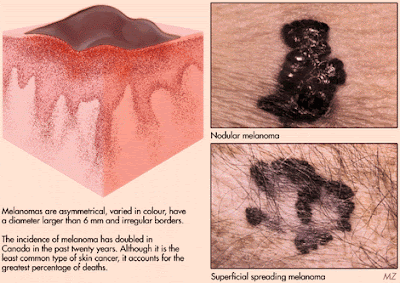Skin Cancer Symptoms/ Signs of Skin Cancer
What is Skin Cancer?
Skin cancers include melanoma, basal cell, and squamous cell. Basal and
squamous cell are common and treatment is very effective. Malignant
melanoma can be difficult to treat. Early diagnosis and treatment can
increase the survival rate from melanoma.
Where skin cancer develops (Skin Cancer)
Skin cancer develops primarily on areas of sun-exposed skin, including the scalp, face, lips, ears, neck, chest, arms and hands, and on the legs in women. But it can also form on areas that rarely see the light of day — your palms, beneath your fingernails or toenails, and your genital area.
Skin cancer affects people of all skin tones, including those with darker complexions. When melanoma occurs in people with dark skin tones, it's more likely to occur in areas not normally exposed to the sun.
Basal Cell Carcinoma Signs and Symptoms (Skin Cancer)
Basal cell carcinoma usually occurs in sun-exposed areas of your body, such as your neck or face.
Basal cell carcinoma may appear as:
• A pearly or waxy bump
• A flat, flesh-colored or brown scar-like lesion
Squamous Cell Carcinoma Signs and Symptoms (Skin Cancer)
Most often, squamous cell carcinoma occurs on sun-exposed areas of your body, such as your face, ears and hands. People with darker skin are more likely to develop squamous cell carcinoma on areas that aren't often exposed to sun, such as the legs and feet.
Squamous cell carcinoma may appear as:
• A firm, red nodule
• A flat lesion with a scaly, crusted surface
Melanoma Skin Cancer Signs and Symptoms (Skin Cancer)
Melanoma can develop anywhere on your body, in otherwise normal skin or in an existing mole that becomes cancerous. Melanoma most often appears on the trunk, head or neck of affected men. In women, this type of cancer most often develops on the lower legs. In both men and women, melanoma can occur on skin that hasn't been exposed to the sun.
Melanoma can affect people of any skin tone. In people with darker skin tones, melanoma tends to occur on the palms or soles, or under the fingernails or toenails.
Melanoma signs include:
• A large brownish spot with darker speckles
• A mole that changes in color, size or feel or that bleeds
• A small lesion with an irregular border and portions that appear red, white, blue or blue-black
• Dark lesions on your palms, soles, fingertips or toes, or on mucous membranes lining your mouth, nose, vagina or anus
Signs and Symptoms of Less Common Skin Cancers
Other, less common types of skin cancer include:
• Kaposi sarcoma. This rare form of skin cancer develops in the skin's blood vessels and causes red or purple patches on the skin or mucous membranes. Kaposi sarcoma mainly occurs in people with weakened immune systems, such as people with AIDS, and in people taking medications that suppress their natural immunity, such as people who've undergone organ transplants. Kaposi sarcoma can also occur in young men living in Africa or older men of Italian or eastern Jewish heritage.
• Merkel cell carcinoma. Merkel cell carcinoma causes firm, shiny nodules that occur on or just beneath the skin and in hair follicles. Merkel cell carcinoma is usually found on sun-exposed areas on the head, neck, arms and legs.
• Sebaceous gland carcinoma. This uncommon and aggressive cancer originates in the oil glands in the skin. Sebaceous gland carcinomas — which usually appear as hard, painless nodules — can develop anywhere, but most occur on the eyelid, where they're frequently mistaken for other eyelid problems.






This comment has been removed by the author.
ReplyDeleteонкология симптомы I think this is an informative post and it is very useful and knowledgeable. therefore, I would like to thank you for the efforts you have made in writing this article.
ReplyDelete